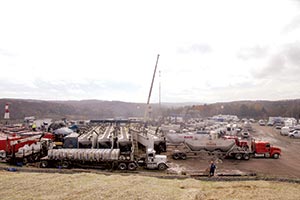Senior Reporter
FMCSA Denies ATA’s HOS Request to Exempt Drivers at Drilling Sites

Federal regulators have denied American Trucking Associations’ hours-of-service exemption request that would have allowed truck drivers working at natural gas and oil sites to exclude waiting time from their calculations of on-duty time.
Currently, only specially trained drivers of commercial motor vehicles that are constructed to service oil and natural-gas extraction sites may use the exemption.
ATA had proposed the Federal Motor Carrier Safety Administration issue a limited two-year exemption to permit exclusion of such waiting time from drivers’ 14-hour duty day when they have a proper place to rest.
The trade federation argued that trucks equipped with sleeper berths and on-site bunking or resting facilities would satisfy the “rest opportunity” standard.
“ATA believes the proposed exemption would encourage these drivers to obtain quality rest at extraction sites and would provide an improved standard for state officials enforcing waiting time requirements,” ATA said.
However, FMCSA officials concluded that ATA did not demonstrate how the commercial vehicle
operations under such an exemption “would achieve a level of safety equivalent to or greater than the level of safety obtained in the absence of the exemption.”
“Fatigue during the workday represents the greatest safety risk because the 60- and 70-hour rules would remain in effect if the exemption or petition were granted,” FMCSA said in the denial announcement posted in the Federal Register on March 28.
“This creates the potential for extremely long workdays provided the individual has not accumulated 14 hours of on-duty time prior to completing his or her driving tasks for the day,” the announcement said. “This may represent an extreme condition, but the current waiting-time exception does not include a limit, and the ATA’s request would extend this potentially risky option to a wider population of oil and natural-gas workers.”
“We’re disappointed with the agency’s decision,” said Sean Garney, ATA’s director of safety policy.
“We felt we offered a pragmatic solution to a reinterpretation of the current oil field exception.”
Garney said ATA was not advocating that a driver rest sitting in a truck seat but rather in a sleeper berth or some rest facility.
But FMCSA said that, generally, a driver may not record time as “off-duty” unless he or she has been relieved of all duty and responsibility for the care and custody of the vehicle, its accessories and its cargo, and is free to pursue activities of his or her choosing.
“Thus, drivers who are waiting, whether at a loading dock or at a natural gas or oil well site, are generally considered to be ‘on-duty,’ ” the agency said.
FMCSA said it received 37 comments representing various transportation interests in response to the proposed exemption, 21 of which supported it. Eleven commenters opposed granting the exemption, including the Advocates for Highway and Auto Safety and the Commercial Vehicle Safety Alliance.
In a separate Federal Register announcement a day later, FMCSA extended an hours-of-service exemption to the Oregon Trucking Association for certain timber operations from March 18, 2017, to March 18, 2020.
The agency’s decision exempts certain commercial motor vehicle drivers engaged in interstate logging originating in Oregon forestlands from the 30-minute rest break provision. It applies to those periods when the state’s Department of Forestry has restricted the transportation of logs because of an elevated risk of forest fire.
FMCSA concluded that limiting those drivers to a fixed 12-hour window would promote safety at least as effectively as the 30-minute break. The agency also noted that these drivers are similar to certain shorthaul drivers who are permitted to follow a 12-hour duty period during which they are exempt from the rest break requirement.
Staff Reporter David Elfin contributed to this story.




